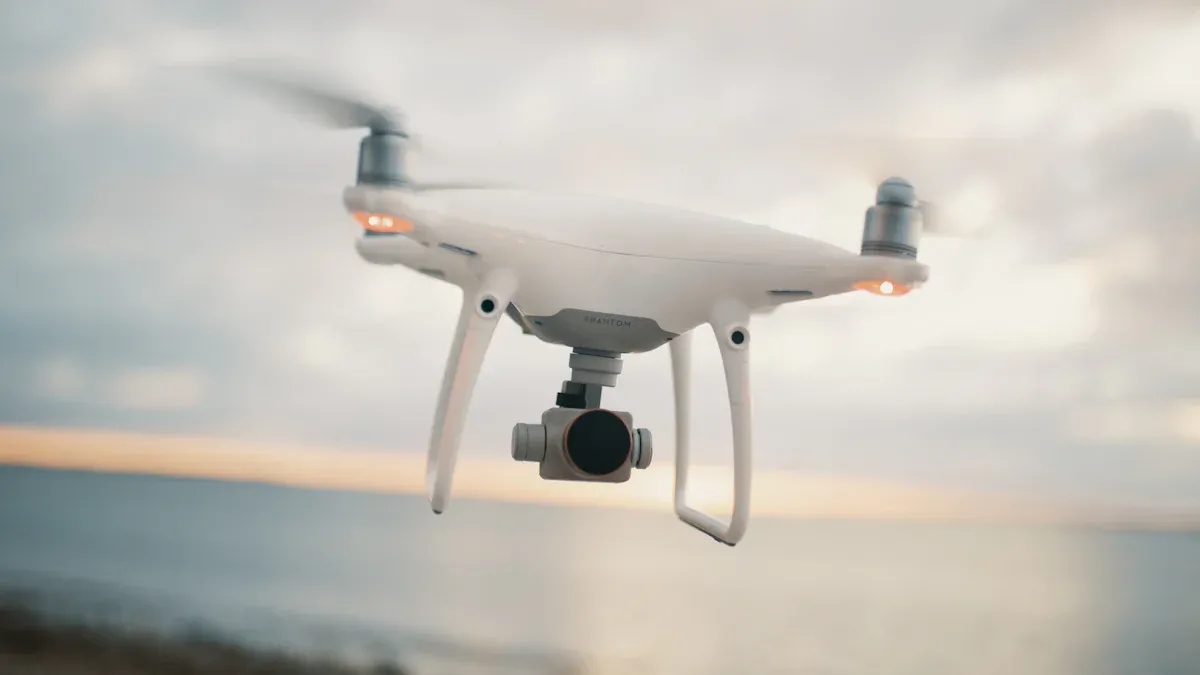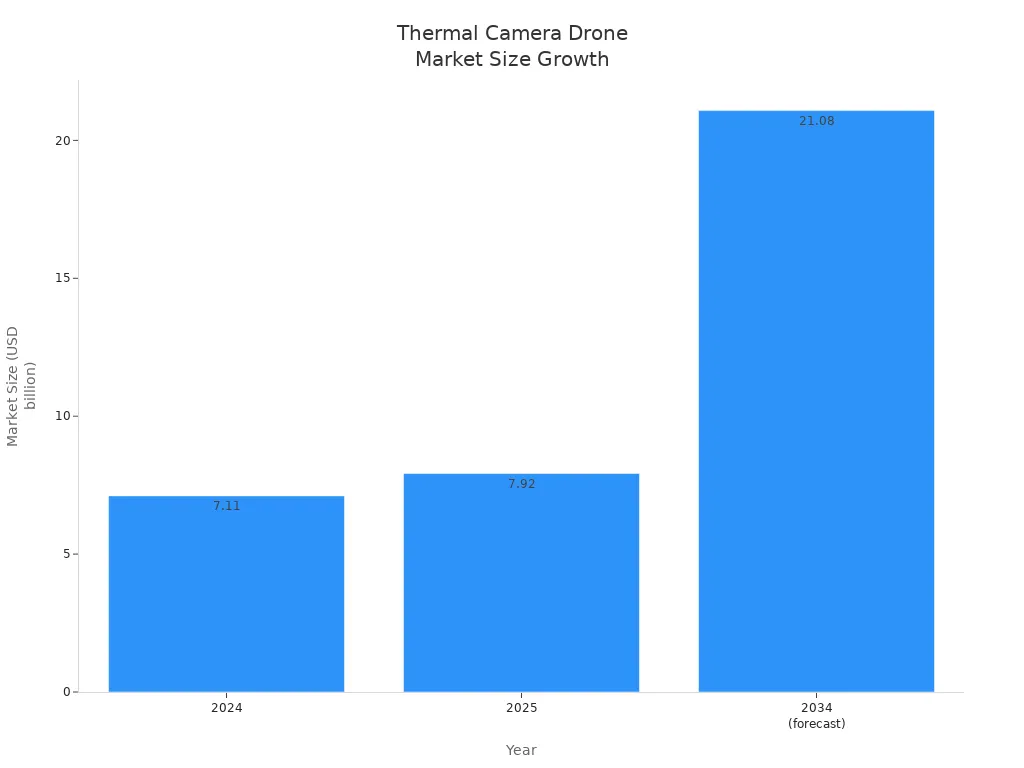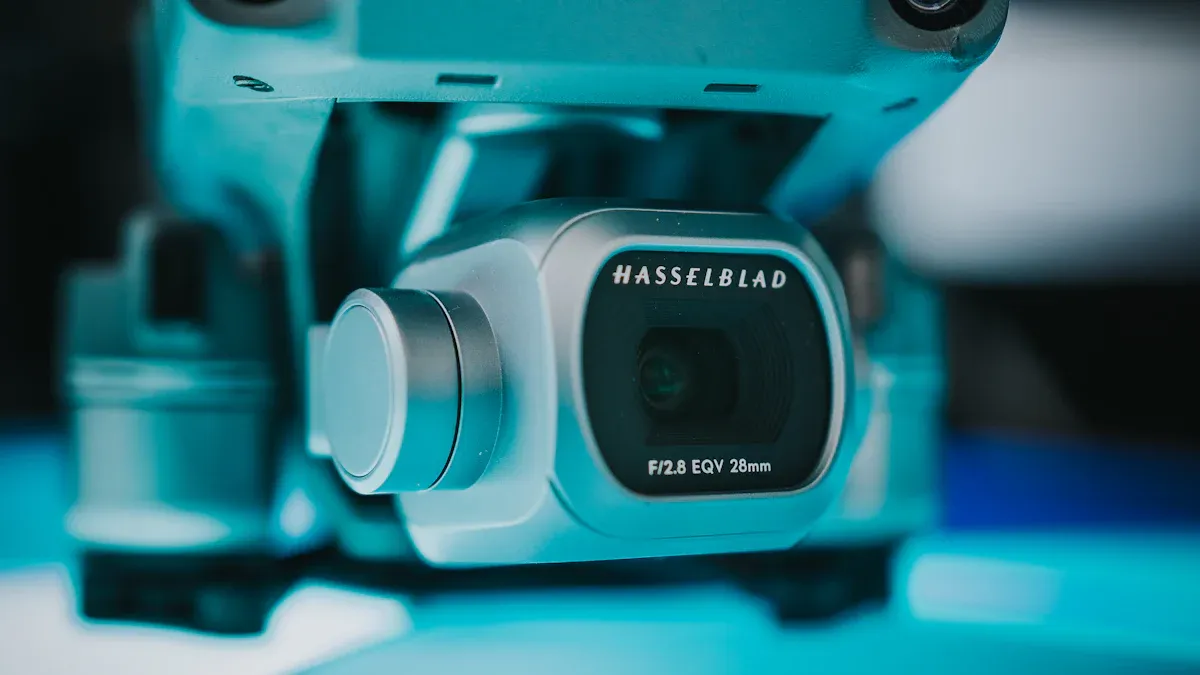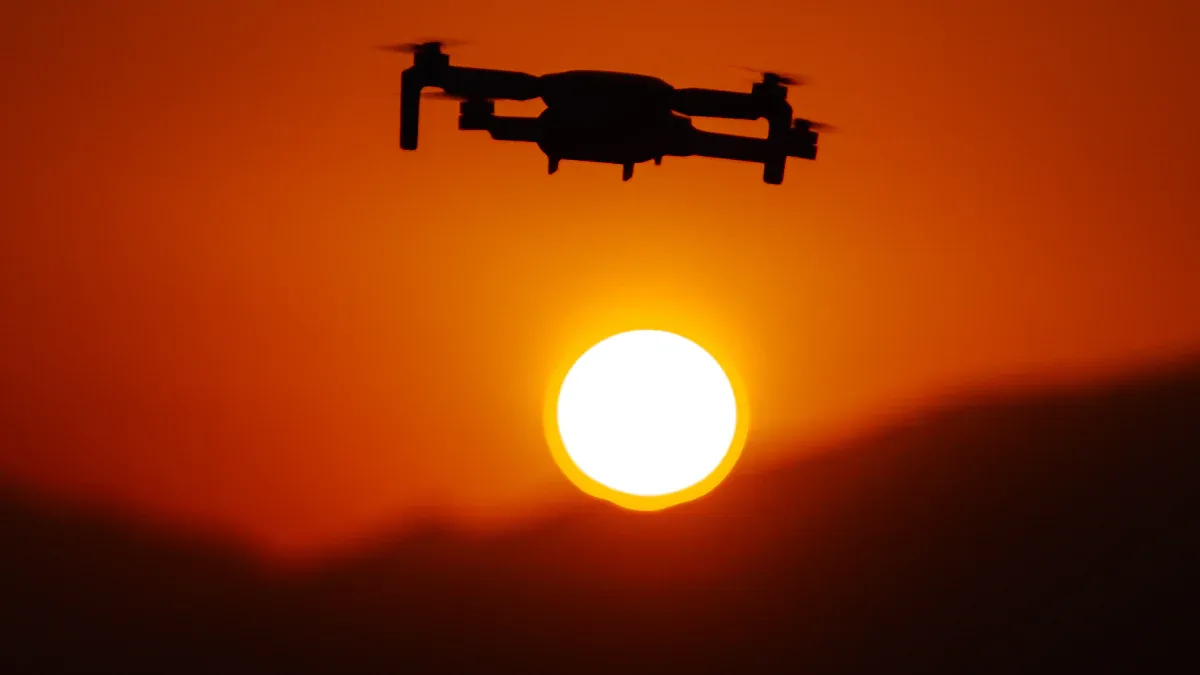
Looking for the best thermal camera for drone adventures in 2025? Here’s a quick list you can’t miss:
DJI Mavic 3T
Autel EVO Max 4T
DJI Matrice 30T
DJI Matrice 350 RTK
DJI Zenmuse H20T
Parrot Anafi USA
Anzu Raptor Thermal
DJI Matrice 4T
FLIR Vue TZ20-R
Workswell WIRIS Pro

Choosing the right thermal camera for drone use can change how you work or play. With thermal drones now leading in inspections, search and rescue, and security, you need to pick a thermal camera that matches your needs. Each model stands out with unique features and performance, so think about what matters most to you before you fly.
Key Takeaways
Thermal cameras on drones show heat that normal cameras miss. This helps with rescue, inspections, and safety jobs.
Using thermal drones keeps you safe. You can check dangerous places from far away. It also costs less than using helicopters.
Pick a thermal camera with high resolution and sensitivity. This helps you find small problems fast and clearly.
Make sure your thermal camera fits your drone. It should also match your job needs for the best results and value.
Thermal drones work in smoke, darkness, and bad weather. This makes them strong tools for many real-world jobs.
Why Use a Thermal Camera for Drone
Expanding Drone Applications
Thermal drones help you see things from above in new ways. A thermal camera for drone use shows things that normal cameras cannot. Drones now do more than just take pictures or videos.
Firefighters use thermal drones to find fires and hot spots, even if there is smoke or it is dark.
Power companies use drones to check power lines and spot problems before they get worse.
Roof inspectors use thermal imaging drones to find heat leaks and help save energy in buildings.
Search and rescue teams use thermal drones to find missing people by their body heat, even in bad weather or at night.
New technology has made these tools stronger. You can now use drones to fly by themselves and scan with thermal cameras. Swarm technology lets many drones work together to check big areas or fight fires. Real-time data fusion mixes thermal, RGB, and LiDAR data to give you more information. AI-powered analysis helps find problems like hot parts or fire risks, so checks are quicker and better. Smaller sensors mean even little UAVs can carry a thermal camera, so more people can use them.
Note: These new features help you use thermal drones for jobs like emergency response, watching wildlife, farming, and checking buildings.
Key Benefits
Using a thermal camera gives you better ways to check things and stay safe. Here is why many people pick thermal drones:
You can see through smoke, darkness, and fog, which normal cameras cannot do.
Drones keep you safe because you can check dangerous places from far away.
You save money since drones cost less than helicopters or planes for checking from the air.
Thermal cameras find heat, so you can spot hot spots, leaks, or missing people fast.
Real-time streaming lets teams work together and make quick choices during rescues or checks.
Drones can check big areas quickly, so they are good for jobs like power line checks or looking at burned land.
You get clear heat maps to help you plan and act better.
Thermal imaging drones help you see hidden things, work safer, and finish jobs faster. If you do search and rescue, check buildings, or want to try new things, a thermal camera makes your drone much more useful.
How Thermal Cameras Work

Thermal Imaging Basics
Have you ever thought about how a thermal camera shows things your eyes can’t see? This tool finds heat, which is called infrared radiation. Everything gives off some heat, even if it feels cold. If something is warmer, it gives off more infrared energy.
A thermal camera has a sensor called a microbolometer. This sensor catches the heat and changes it into signals. An image processor takes these signals and makes a picture. The picture shows different temperatures as colors. Hot spots might look white or red. Cooler spots can look blue or purple. Special lenses, like germanium lenses, help focus the heat onto the sensor. This is how you get a thermal image.
Thermal cameras do not need light to work. You can use them in darkness, smoke, or fog. That is why thermal drones are great for hard jobs. You can see heat that your eyes cannot. This helps you find things like missing people, water leaks, or gaps in insulation.
Tip: Weather, surface type, and drone angle can change what you see in thermal images. Always check your settings to get the best results!
Advantages for Drones
When you put a thermal camera on a drone, you can do many new things. Drones with thermal cameras can fly over big areas fast and safely. You do not need to send people into risky places. You can stay safe while the drone does the work.
Here is why thermal drones are special:
You can check large spaces quickly, which helps in emergencies.
Drones can find heat in forests, cities, or mountains, even at night.
Real-time thermal data helps you make fast choices and work with others.
You save money because you do not need helicopters or big teams.
Drones with thermal cameras work in darkness, smoke, or fog, so you do not miss anything important.
Thermal imaging makes your drone smarter and more helpful. You can use it for checks, rescues, or watching animals. With thermal drones, you get clear and useful information when you need it.
Buying Guide
Resolution & Sensitivity
When you choose a thermal camera, look at sensor resolution and sensitivity first. A higher sensor resolution gives you clearer and sharper thermal images. This helps you find small problems from far away. It is very useful for inspections or research. Sensitivity is also very important. It shows how tiny a temperature change the camera can notice. Cameras with better sensitivity (lower NETD values) show more details, even in fog or dust. For example, a camera with 20 mK sensitivity shows heat differences much better than one with 50 mK. If you want to find small leaks or hidden problems, pick a thermal camera with high sensor resolution and great sensitivity.
Compatibility & Integration
Not all thermal cameras work with every drone. You must check if the camera fits your drone model. Some cameras, like the Workswell WIRIS Pro, work well with DJI Matrice drones. Others, like the FLIR Vue TZ20-R, fit many different drones. Look at the table below for some examples:
Thermal Camera Model | Drone Compatibility | Key Integration Features |
|---|---|---|
Workswell WIRIS Pro | DJI Matrice 300, DJI Matrice 350 | Advanced imaging, radiometric accuracy |
FLIR Vue TZ20-R | Most drone platforms, DJI Matrice | Dual thermal cameras, 20x zoom, radiometric data |
You should also think about gimbal stabilization and software. A good gimbal keeps your images steady, even if the drone moves. Make sure your drone can carry the camera’s weight and use its special features.
Price & Value
Thermal cameras have many different prices. You do not always need the most expensive one. Think about what you want to do with it. If you only need simple checks, a basic camera may be enough. For search and rescue or detailed inspections, you may need a better model. Experts say you should match the camera’s features to your job. Try to find the best balance between price and what you get. Always test the camera before using it outside. This way, you know it works for you.
Tip: Pick a thermal camera that matches your main job. This helps you get the most for your money.
Best Thermal Drones 2025
DJI Mavic 3T
The DJI Mavic 3T is small but strong. It has two cameras: a thermal camera and a high-quality visual camera. You can take both thermal and normal pictures at once. This makes checking buildings or searching for people much easier.
Here’s what the Mavic 3T can do:
Feature Category | Details |
|---|---|
Dual-Sensor System | Thermal + high-res visual camera |
Thermal Camera Resolution | |
Thermal Sensitivity | ≤50 mK @ F1.1 |
Thermal Zoom | 28x digital zoom |
Visual Camera Zoom | 56x hybrid zoom |
Flight Time | Up to 45 minutes |
Obstacle Sensing | Omnidirectional sensors with DJI APAS 5.0 |
Positioning System | High-precision RTK |
Transmission Range | Up to 15 km |
Weight | 920 g |
You can fly for 45 minutes and see big areas. The sensors help you avoid hitting things. The Mavic 3T is good for checking buildings, finding people, and keeping people safe. You get clear thermal pictures and can zoom in to see details from far away.
Tip: The Mavic 3T is light and folds up small. You can carry it anywhere. It is a smart pick if you want a strong thermal camera for drone work.
Autel EVO Max 4T
The Autel EVO Max 4T is great for hard jobs. It has a FLIR Boson thermal camera and a strong visual camera. You can see heat and normal images together. This drone is made for tough missions.
Pros:
The bright screen makes flying simple.
Special shielding keeps your signal strong.
3D mapping tools help you plan and check big places.
Sensors all around help you stay safe.
You can fly many drones together with A-MESH.
720° obstacle avoidance gives extra safety.
Your data is safe with AES-256 encryption.
It can handle rain and dust with IP43 protection.
Cons:
It is heavy, so carrying it is harder.
The special features take time to learn.
Extra batteries cost a lot.
You can use the EVO Max 4T for rescue, checking power lines, or watching animals. It handles lots of data and works well in rough places.
DJI Matrice 30T
The DJI Matrice 30T is a top pick for emergency teams and inspectors. You can set it up fast and fly in bad weather. It has three cameras: wide, zoom, and thermal camera.
Feature | DJI Matrice 30T |
|---|---|
Environmental Protection | IP55 (dust and water splash resistant) |
Operating Temperature Range | -20°C to +50°C |
Weight | Approx. 3.7 kg |
Flight Time | |
Transmission Range | 15 km |
Camera System | Wide (12 MP), zoom, thermal (640×512) |
Payload Flexibility | Fixed configuration |
AI Capabilities | Limited |
Laser Rangefinder | Up to 1200 meters |
Portability | Highly portable, quick deployment |
Use Cases | Emergency response, public safety, industrial inspections |
You can use the Matrice 30T for fighting fires, helping after disasters, or checking factories. It is strong and sets up quickly. You get clear thermal images and can fly in strong wind.
DJI Matrice 350 RTK
The DJI Matrice 350 RTK is made for big jobs. You can carry three cameras or tools at once, like the Zenmuse H20 series and H20N. These have thermal, zoom, and wide cameras. You can also use other tools with it.
It has a night vision camera for flying in the dark.
Two batteries let you fly longer and change batteries fast.
It works with all M300 tools, so you can use old gear.
Smart software helps you get clear images and track things.
The strong body and sensors keep you safe.
You can use the Matrice 350 RTK for checking power lines, rescue, or mapping big places. It is flexible and powerful, so it is great for people who need the best.
DJI Zenmuse H20T
The DJI Zenmuse H20T is a camera that does many things. It has a 20 MP zoom camera, a 12 MP wide camera, a laser rangefinder, and a radiometric thermal camera. You can zoom in up to 200x and use AI Spot-Check to compare inspection spots.
The H20T gives sharp pictures and accurate temperatures. You can use it for checking factories, public safety, or rescue. It stays steady and works in bad weather (IP44). If you need great visual and thermal data, the H20T is a smart choice.
Parrot Anafi USA
The Parrot Anafi USA is fast and reliable for emergencies and checks. You can launch it in less than a minute. It works in rain, dust, and wind with its IP53 rating.
The 32x zoom lens helps you see far.
The FLIR Boson thermal camera finds people or hot spots, even at night.
It flies up to 32 minutes.
Data encryption keeps your mission safe.
Real-time mapping with Pix4Dreact software.
It is quiet, so it is hard to hear.
It meets U.S. security rules.
You can use the Anafi USA for rescue, police work, or checking buildings. It sets up fast and keeps your data safe.
Anzu Raptor Thermal
The Anzu Raptor Thermal is light and advanced. It focuses on security and accuracy. It has a high-resolution 640 × 512 thermal camera that measures each pixel’s temperature. RTK gives you very exact results. It can fly up to 45 minutes.
Sensors all around help you avoid obstacles.
56x hybrid zoom lets you see tiny things.
Low-light mode helps you fly at night.
No geofencing means you can fly anywhere.
Fast charging means less waiting.
Data is stored safely in the U.S.
It works with DJI Mavic 3 accessories.
You can use the Raptor Thermal for checks, mapping, or public safety. Its features and security make it a top pick for pros.
DJI Matrice 4T
The DJI Matrice 4T is made for real-time work. You get both thermal and normal camera views. AI tracking helps you find things fast. The strong body and folding arms let you set it up quickly.
Specification | DJI Matrice 4T Details |
|---|---|
Photo Resolution | Infrared: 1280×1024 (Super Resolution), 640×512 (off) |
Digital Zoom | 28x |
Temperature Measurement | High Gain: ±2°C or ±2%, Low Gain: ±5°C or ±3% |
Obstacle Sensing | Omnidirectional binocular vision + 3D infrared sensor |
Operating Temperature | -20°C to 50°C |
Flight Time |
You can use the Matrice 4T for safety, firefighting, or checking important places. AI tracking, night vision, and sensor fusion help you find people or problems fast, even in smoke or dark.
FLIR Vue TZ20-R
The FLIR Vue TZ20-R is a great thermal camera for drone missions that need clear images. It has two thermal sensors. You get a wide 95º view and a narrow 18º view. It has 5x optical zoom and up to 20x digital zoom. You can see details from far away.
The TZ20-R works with DJI Matrice drones and is easy to connect. Its radiometric tech gives you accurate temperatures for every pixel. The IP44 rating keeps it safe from dust and water. You can use the TZ20-R for police, firefighting, or checking factories. Its zoom and easy setup make it a favorite for hard jobs.
Workswell WIRIS Pro
The Workswell WIRIS Pro is a strong thermal camera for drones. It is made for detailed checks. It has high thermal resolution (up to 800×600 pixels), great sensitivity, and up to 30x optical zoom. It records full radiometric data, so you can check temperatures and look at images later.
Aspect | Details / Advantages | Limitations / Considerations |
|---|---|---|
Thermal Resolution | Up to 800×600 pixels | Weight may limit drone payload capacity |
Thermal Sensitivity | Excellent, e.g., 40 mK | Need for trained personnel |
Optical Zoom | Up to 30x optical zoom | |
Radiometric Data | Full radiometric data capture | |
Camera Integration | Thermal + visible light cameras | |
GPS Integration | GPS coordinates in image metadata | |
Remote Control | Full remote control of camera settings during flight |
You can switch between thermal and normal cameras while flying. The camera adds GPS tags and works with many tools. You need some training to use all the features. You get detailed and correct results. The WIRIS Pro is great for checking factories, roofs, and research.
To pick the best thermal drone, think about what you need most: flight time, camera quality, or special features. Each of these advanced thermal drones has something special, so you can find the right one for your next job.
Comparison Table
Do you want to compare these drone cameras easily? This table puts all the main facts together. You can quickly see what makes each one different. It helps you choose the best camera for your job.
Model | Thermal Resolution | Sensitivity (NETD) | Flight Time | Zoom | Weight | IP Rating | Special Features | Best Use Case |
|---|---|---|---|---|---|---|---|---|
DJI Mavic 3T | 640×512 @ 30Hz | ≤50 mK | 45 min | 28x digital | 920g | N/A | Dual camera, RTK, compact | Inspections, SAR |
Autel EVO Max 4T | 640×512 | ≤50 mK | 42 min | 16x digital | 1.35kg | IP43 | A-MESH, 3D mapping, encryption | Rescue, utilities |
DJI Matrice 30T | 640×512 | ≤50 mK | 41 min | 16x digital | 3.7kg | IP55 | Triple camera, laser rangefinder | Emergency, industry |
DJI Matrice 350 RTK | 640×512 (H20T) | ≤50 mK | 55 min | 23x hybrid | 6.47kg | IP45 | Multi-payload, RTK, AI | Mapping, inspection |
DJI Zenmuse H20T | 640×512 | ≤50 mK | N/A | 200x hybrid | 828g | IP44 | Laser rangefinder, AI Spot-Check | Industrial, safety |
Parrot Anafi USA | 320×256 | ≤50 mK | 32 min | 32x digital | 500g | IP53 | Fast launch, encrypted data | Public safety, surveys |
Anzu Raptor Thermal | 640×512 | ≤50 mK | 45 min | 56x hybrid | 915g | N/A | RTK, no geofencing, US storage | Security, mapping |
DJI Matrice 4T | 1280×1024 (SR), 640×512 | ≤50 mK | 45 min | 28x digital | 3.8kg | IP45 | AI tracking, night vision | Firefighting, safety |
FLIR Vue TZ20-R | Dual 640×512 | ≤50 mK | N/A | 20x digital | 640g | IP44 | Dual sensors, radiometric data | Police, inspection |
Workswell WIRIS Pro | 800×600 | ≤40 mK | N/A | 30x optical | 780g | N/A | Full radiometric, GPS tagging | Research, industry |
Tip: Pick a camera with high thermal resolution and sensitivity for clear images. If you need to fly longer, check the flight time and weight. Some drones have cool extras like AI tracking or laser rangefinders to help with hard jobs.
Thermal camera resolution lets you see small details.
Sensitivity (NETD) helps you notice tiny temperature changes.
Flight time shows how long your drone can fly.
Zoom helps you look closer without moving the drone.
IP rating tells you how well the drone handles dust and water.
This table helps you find the right camera for your needs. You can pick a light drone for quick jobs or a big one for tough work. There are many good choices for everyone.
Thermal Drones in Action

Real-World Uses
Thermal drones help with hard jobs. They let you find problems fast. You can keep people safe with them. These drones work in many areas. They show you things your eyes cannot see.
Here are ways people use thermal drones every day:
Sector | Use Case Description | Practical Benefits |
|---|---|---|
Construction & Infrastructure | Finding insulation leaks, gaps, and hot spots in buildings and bridges | Saves time and money, targets repairs |
Firefighting & Emergency | Locating hotspots, planning rescues, and managing wildfire boundaries | Boosts safety and speed |
Search and Rescue | Detecting people by body heat in darkness or rough terrain | Faster, easier rescues |
Agriculture & Precision Farming | Checking crop health, water stress, and livestock location | Quick response to issues |
Energy Sector & Power Lines | Spotting overheated parts in power lines, solar panels, and wind turbines | Prevents failures, cuts downtime |
Environmental & Wildlife | Tracking animals and habitats using heat signatures | Non-intrusive, supports conservation |
Roof & Solar Panel Maintenance | Finding leaks, insulation gaps, and broken solar panels | Better energy use, easier maintenance |
You can use thermal drones to check bridges or buildings. Firefighters use them to find hot spots. Farmers use them to look at crops and animals. In search and rescue, you can find missing people by their body heat, even at night. These real-life uses show how thermal drones make work safer and faster.
Pro Tips
Want to use your thermal drone better? Try these easy tips:
Pick a camera with good resolution for your job. High resolution helps you see small things from far away.
Choose the right field of view. Use a narrow view for far targets. Use a wide view for big areas.
Fly when it is cool and dry. Heat and wet air can change your images.
Use thermal zoom and image tools. These help you find problems faster.
Look for things with big temperature changes. This makes them easier to see.
Learn to read thermal images. Training helps you not make mistakes.
Use other sensors, like LiDAR, with your thermal data for better results.
Always check the weather before you fly. Rain, fog, or snow can make images hard to see.
Tip: Practice flying your thermal drone often. The more you fly, the better you get at finding problems and helping in rescues.
The best thermal cameras for drones in 2025 give you clear pictures and can sense small changes in heat. Some cameras have cool features, like showing two images at once. If you are an expert, pick a camera with high resolution and special tools. If you are just starting, choose a simple camera that does not cost much. Always pick a camera that fits your job, like rescue, checking things, or watching animals. If you want to know more, you can take a free class about drone thermography or join a group to get help and tips. 🚁
FAQ
What is the main difference between thermal and regular cameras on drones?
Thermal cameras show heat, not just light. You see temperature changes, not colors or shapes. This helps you spot things like people, animals, or hot spots that regular cameras miss.
Can I use any drone with a thermal camera?
No, not every drone works with a thermal camera. You need to check if your drone supports the camera’s size, weight, and connection. Some cameras only fit certain drone models.
How do I read a thermal image?
You look for color changes. Hot spots show up as white, yellow, or red. Cooler areas look blue or purple. Most cameras let you change the color palette to make things easier to see.
Do I need special training to use a thermal drone?
You don’t need a license for most hobby use, but training helps a lot. You learn how to spot problems and avoid mistakes. Many companies offer short courses or online videos.
What jobs can I do with a thermal drone?
You can inspect roofs, find missing people, check crops, or spot fires. Many people use thermal drones for safety, rescue, farming, and building checks. The uses keep growing every year!
Tip: Always check your local drone rules before you fly with a thermal camera.
See Also
The Importance Of Thermal Imaging Cameras In 2025
Vanadium Oxide Thermal Cameras Designed For Rescue Missions
Using Thermal Imaging Cameras For Search And Rescue In 2025
Best AI Video Boxes For Vehicles Reviewed In 2025
Top Wireless CarPlay Adapters To Enhance Your Driving Experience
